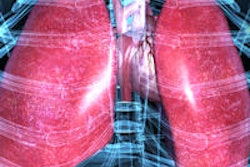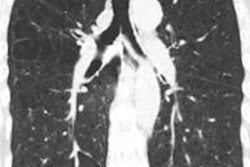
Lung cancer screening with CT and spirometry delivers a high rate of diagnosis of early-stage lung cancers and reduces mortality in individuals with mild to moderate chronic obstructive pulmonary disease (COPD), according to a pilot study in Respiratory Medicine.
Researchers from Spain and the U.S. found that in a population of more than 600 individuals, patients with COPD who were screened with CT had far lower mortality rates, with disease detected at an earlier stage. The findings suggest that COPD status could be an important factor to consider -- in addition to smoking status -- when designing a CT lung screening program.
The study also affirms the utility of spirometry in lung cancer screening of COPD patients, wrote Dr. Juan de Torres from Cliníca Universidad de Navarra in Pamplona, along with colleagues from Hospital Universitario Nuestra Señora de Candelaria in Tenerife, Hospital Universitario Miguel Servet in Zaragoza, and Brigham and Women's Hospital in Boston (Respiratory Medicine, May 2013, Vol. 107:5, pp. 702-707).
Does screening COPD cut mortality?
While smoking gets most of the attention as a contributor to lung cancer, COPD is also an independent risk factor, especially in patients with mild to moderate disease, de Torres and colleagues wrote. The group's recent research has shown that risk is highest in COPD patients in categories 1 and 2 of the Global Initiative for Chronic Obstructive Lung Disease (GOLD) classification system. Among these individuals, the risk is even higher for those with alterations of the diffusing capacity for carbon monoxide (DLCO) or evidence of emphysema on CT.
The pilot study aimed to determine if screening patients with mild to moderate COPD based on the GOLD criteria would reduce lung cancer mortality. The researchers analyzed disease incidence, stage distribution, and mortality in two cohorts of patients with GOLD stages 1 and 2 COPD, who were matched for age, gender, pack-year history, and smoking status, among other factors.
The screening group underwent annual low-dose CT (LDCT) scans, while the control group was followed prospectively with usual care. Each group consisted of 333 individuals. Mean follow-up time was 31 months for the screening group and 56 months for the control group.
Over the 31-month follow-up period, 20 (6%) of the 333 individuals in the screening group and 20 (6%) in the control group developed lung cancer, the researchers reported. However, the big difference between the groups was the stage at which cancer was detected and patient mortality.
Fully 80% (16/20) of the cancers in the screening group were diagnosed in TNM stage I, while all cancers in the control group (35/35) were diagnosed in stages III and IV, de Torres and colleagues wrote. This may have affected patient mortality, as only one patient in the screening group had died of lung cancer at 31 months, compared with 12 deaths in the control group.
The findings suggest that "actively screening for lung cancer using LDCT in patients with mild to moderate COPD ... results in a high rate of diagnosis of lung cancer in early, curable stages, and in high long-term survival rates," the authors wrote. "Our data also suggests that without screening, lung cancer is detected in more advanced stages and results in many avoidable deaths."
A 'COPD-centric' approach
The higher rate at which de Torres and colleagues detected lung cancer was comparable to rates in studies such as the National Lung Screening Trial (NLST), which based screening criteria solely on smoking history and age. While NLST was great news on several fronts, it raised additional questions about screening, commented Dr. Robert Young and Raewyn Hopkins from the University of Auckland in a letter to the editor published online February 12, 2014, in Respiratory Medicine.
The study by de Torres et al is encouraging because it offers a path toward a much higher detection rate from lung cancer screening, they wrote. For starters, the group's lung cancer detection rate for COPD patients was approximately 3.8 times higher than what was reported in NLST.
The results are also in line with a re-analysis of data from the Pittsburgh Lung Screening Study (PLuSS), which also examined individuals with mild to moderate COPD. The number needed to screen (NNS) to find a single lung cancer in the Pittsburgh study was just 1 in 43 people with mild to moderate COPD -- versus 1 in 164 participants in NLST, Young and Hopkins noted.
Further studies are needed, but the results of de Torres et al raise important issues about targeted screening, they wrote. First, limiting the screening population to individuals with mild to moderate COPD reduces eligibility to only about 50% of those who develop lung cancer -- hardly better than the 47% estimated under the NLST criteria, when strict age and smoking criteria are used.
Another interesting finding was the apparent "absence" of overdiagnosis reported by Torres et al, Young and Hopkins wrote. The number of cancers was equal (n = 20) in the screening and control arms when patients were matched for demographics and follow-up time.
In contrast, other recent studies have found more cancers in the screening arm. In fact, previous CT studies that relied only on age and smoking histories logged an "excess" of 35% to 65% cancer cases in the CT arm versus controls, they wrote.
Finally, if targeted screening of high-risk individuals benefits those with COPD, then spirometry must be incorporated into the screening protocols of asymptomatic smokers.
"Indeed, if anything like the 12-fold decrease in mortality described by de Torres and colleagues is confirmed in a larger study, then discouraging the routine use of spirometry to diagnose these early forms of COPD in asymptomatic current or former smokers may be completely unjustified," they wrote.
While a larger study is needed to confirm the findings, there is growing evidence that a "COPD-centric" approach to lung cancer screening holds many advantages over current criteria that restrict eligibility to age and smoking history, Young and Hopkins concluded.




















